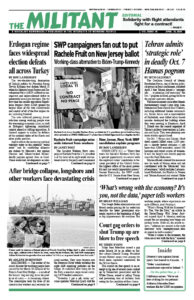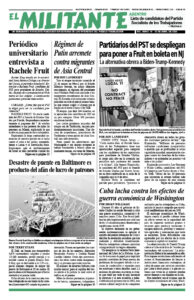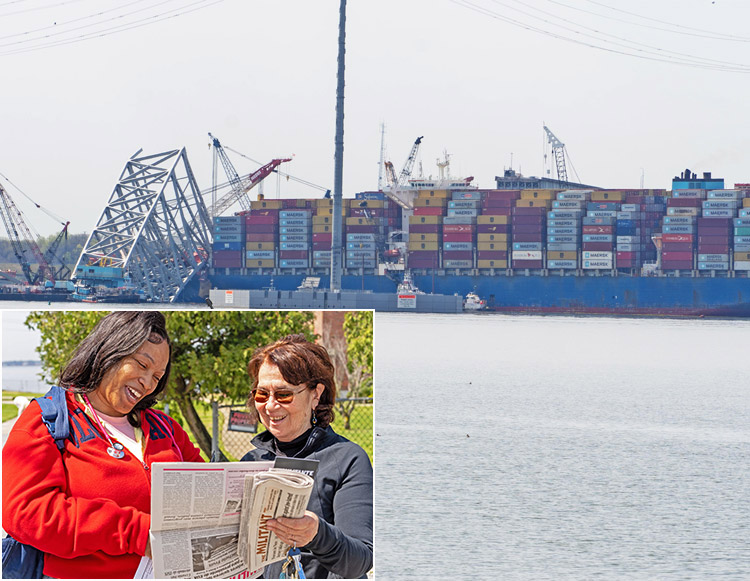BALTIMORE — The extent of the social disaster for working people here caused by the March 26 collapse of the Francis Scott Key Bridge — a result of the bosses’ dog-eat-dog drive for profits at all costs — is becoming clearer. The catastrophe took the lives of six construction workers and seriously injured another. They were thrown into the Patapsco River while working the night shift repairing potholes on the bridge. It crumbled after being hit by the Dali, a massive cargo vessel carrying 4,679 loaded containers.
“Yesterday I got a job, today no,” crane operator Malcolm Lynch told the Militant as he was looking at that day’s board April 9 showing job offers for International Longshoremen’s Association Local 333 members. “No job, no paycheck.” He pointed to the job board on the wall, which showed only one opening on the screen.
Some 2,400 members of the ILA work on the Baltimore docks, loading and unloading cargo, driving forklifts, operating cranes and other jobs. They’re paid by the day and building up hours is how they get more seniority, better jobs and higher pay.
While the port is blockaded by the dead ship and massive bridge debris, some will get temporary work while 1,200 others will get a lump-sum payment of between one- and four-weeks’ wages taken from six months vacation pay they’ve accrued. No one knows for certain when they’ll be able to work again. Government officials have said it could be months before ships can safely transit the port again.
There are over 15,000 workers at the port. Another 140,000 jobs in the area depend on its functioning.
The dangers of further disasters like this were driven home April 5 when another massive container ship, the APL Qingdao, lost propulsion power in the Kill Van Kull shipping lane near the Verrazzano-Narrows Bridge in New York. Luckily it was escorted by three tugboats at the time, and three more responded to a call for help. The six tugs got the boat to a safe place to anchor just north of the bridge.
The 21-member crew of the Dali, 20 from India and one from Sri Lanka, are stuck on the boat indefinitely. Even as cargo ships have doubled and tripled in size, the bosses have cut crew size.
At 123,881 tons, the Dali is ranked as a medium-sized ocean vessel compared to the world’s largest container ships, which can carry 24,000 containers.
Big impact on working people
James Harris, Socialist Workers Party candidate for District of Columbia delegate to Congress, visited and expressed solidarity with workers in Dundalk, near the port. The bridge’s collapse “is a disaster that did not have to happen,” Harris explains in an April 1 campaign statement he handed out. “It happened before, to the same bridge in 1980 when the Blue Nagoya drifted into it. The difference was that ship was much smaller. The Dali was three times as big. Nothing was done to reinforce the bridge or to prevent this from happening again.”
Earlier in the week Harris visited the Owls Corner Cafe, a Puerto Rican restaurant that has been organizing solidarity for cook Isabel Franco, whose husband, Jose Mynor Lopez, worked on the bridge that night and didn’t survive. “The restaurant was closed, but owner Lilly Ordoñez told us she is raising funds for the Franco and Lopez family,” Harris said.
The Coast Guard has ended the search for his body, along with those of two others whose bodies haven’t been found.
Socialist Workers Party campaigners, supporters of Harris and Rachele Fruit for U.S. president, returned to talk to workers on their doorsteps. We got a hearing when we pointed to Fruit’s demand for workers control of production, organized by the unions.
“My bills outweigh my income. I have good credit, but the interest is 30%,” lab worker Caleche Arrington said as she let SWP campaigner Glova Scott into her home. “I can only imagine what workers at the port are facing — on top of everything else.” She subscribed to the Militant and got The Low Point of Labor Resistance Is Behind Us: The Socialist Workers Party Looks Forward.
“Thousands are waking up to the reality of what this means for their livelihoods and their families,” Delores DeLibera told us. “But why does your party say it’s ‘capitalist greed?’”
“The same capitalists who made billions from the bridge’s faulty construction throughout its lifespan didn’t care about what the impact might be on working people. They don’t care about us. They exist for profits,” this Militant worker-correspondent replied.
“Well, from that point of view, a lot of the world’s problems are because of capitalist greed,” DeLibera said. She bought a copy of Are They Rich Because They’re Smart? Class, Privilege, and Learning under Capitalism by SWP National Secretary Jack Barnes.
Arrin Hawkins contributed to this article.


